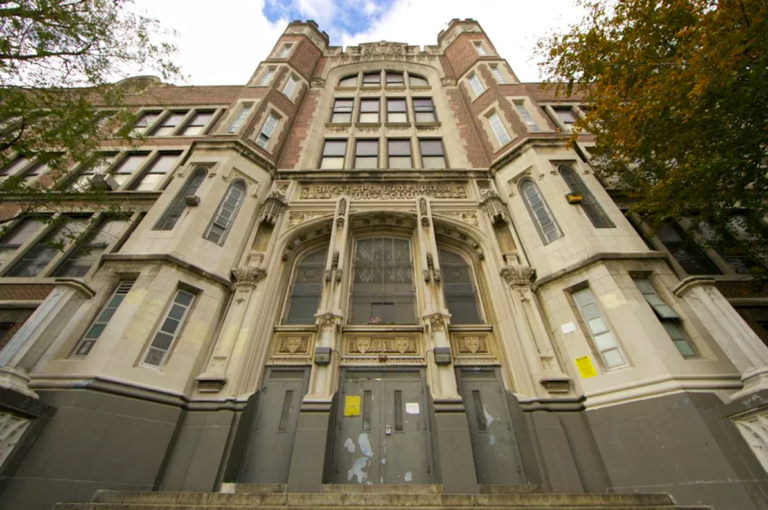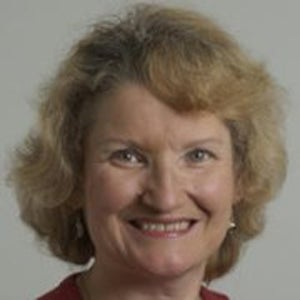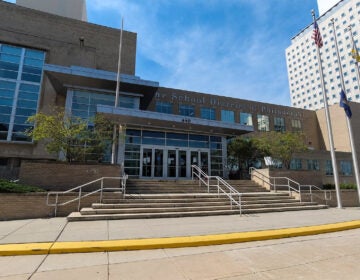Philadelphia board wants to confront equity issues and old assumptions, its president says
Rethinking everything about how the board does business, including long-held practices, is the impetus for the board’s new “goals and guardrails” initiative.

Outside the former West Philadelphia High School. (Nathaniel Hamilton for WHYY)
This story originally appeared on Chalkbeat Philadelphia.
In the Philadelphia school district, teachers typically are allocated based on student enrollment and assigned based on seniority. Class size limits are the same everywhere, with 30 students in kindergarten through third grade, and 33 students in other grades, regardless of a school’s needs or demographics.
These are among the assumptions that have governed how the school district has operated for decades.
It may be time to throw those assumptions and some others out the window, according to the board of education. Rethinking everything about how the board does business, including long-held practices, is the impetus for the board’s new “goals and guardrails” initiative that was announced last month, with all the board members expressing support. They said it is meant to focus their efforts on what really matters — student achievement — and hold themselves and Superintendent William Hite more accountable.
To do that, Joyce Wilkerson, board president, said members of the board are ready to upend accepted norms and practices if they have to, such as the formula for allocating teachers to schools and the method for determining where individual teachers are assigned.
“What we’re doing now isn’t working for too many children,” Wilkerson said. ”We’ve got to start thinking differently.”
For instance, the least experienced teachers often end up in the most high-poverty schools, a result of decades of practice and now codified in hard-fought teachers’ contracts. Historically, that’s because teacher placement has been largely based on seniority and personal choice.
More recently, a site selection process has given principals and other school leaders the ability to recruit for vacancies, but the overall problem remains.
“We can’t say ‘It has always been that way,’ because the outcomes aren’t acceptable,” Wilkerson said. “We want our children to learn and we’re not willing to accept a whole lot of adult behavior as the excuse. We will be tackling tough issues that have resulted in hugely disparate outcomes for kids.”
She said the district should consider student needs, achievement levels, and the degree of poverty in a school when allocating teachers and resources. Some high-need schools also could have smaller class sizes.
“It’s going to be moving resources around. You don’t get equity without moving resources from schools that have more to those that have less,” she said.
Some of the changes would need to be negotiated with the labor unions.
Jerry Jordan, president of the Philadelphia Federation of Teachers, said he favors schools having more resources. But, he added, all Philadelphia schools should have them. “Teachers have always said, ‘Get us what we need for the kids, and we’ll be able to do a better job,’” he said. “When buildings are under-resourced, teachers leave them, and they go to a building where there are more resources. You have to look at the whole picture.”
Jordan said the union would be happy to discuss some of the changes Wilkerson mentioned. But “this is not as simple as just wishing for it.”
For instance, differentiating class size based on the school would need to be studied. “If too many variables occur, it can cause a ripple effect.”
Wilkerson and the board are determined to open this kind of dialogue. “I understand there’s a contract impediment,” she said. “Rather than accepting the problem, we’re creating the expectation that we want to see a solution.”
One of the things she said the board intends to track closely is whether students “are making progress, who’s making progress, and why.”
A report released Wednesday by the Philadelphia School Partnership outlines starkly the racial divide in achievement in the city, and the arguably inequitable access of city students to high-quality schools.
For instance, only 14% of students in K-8 district and charter schools are white. But white students are disproportionately enrolled in schools that are considered high achieving — there are three times more white students than Black students, and four times more white students than Latino students in such schools — which is defined as schools where student achievement is at or above the state average. Black students make up 52% of enrollment in public schools. Latino students account for 21%.
Wilkerson said the board will more closely follow such metrics in its decision-making going forward. She said board members will use a variety of measures to judge school quality, focusing on the relative achievement and progress of subgroups based on race, ethnicity, and English-language ability and special education status.
And the board plans to make more accessible to the public the district’s own considerable research on student achievement and progress, among other issues.
Much of the research, while extensive and available on the district website, is hard to interpret, Wilkerson said.
“We’ve got these reports that are generated, that are extraordinarily dense,” Wilkerson said. “One of the challenges is that it’s not just unintelligible to board members, but to the public writ large.” The board plans to conduct workshops to help people navigate the reports.
And it will be working with the district’s Office of Assessment “in developing reports that get into information that the board wants to see.”
Board members also plan to interact with the public more during board meetings, rather than just listening to complaints and criticisms. They plan to make 10 speaking slots available at each meeting for students, and 30 for the general public, “plus other opportunities” to interact with board members.
Still, there is a lot beyond the board’s control.
Philadelphia is the poorest big city in the nation. More than 80% of students live below federal poverty levels. The appointed board decides how to spend the district’s more than $3 billion budget, but is unable to raise taxes and must rely on the city and state for funds to operate.
Wilkerson said she anticipates the school board will do more to advocate at the state level to address funding inequities, including reform of the charter funding formula. Pennsylvania has some of the largest gaps between wealthy and poor districts of any state in the country.
The nine-member board is appointed by the mayor, and is about to get three new members. Wilkerson said that current members have spent more than a year working this plan.
Hite said he welcomed the board’s new approach, and he said it is past time to confront the equity issue internally and in Pennsylvania. He hopes that it will demonstrate more starkly “what is needed so all children can achieve” the standard of education required to succeed.
“The inequities are clear and glaring,” he said. “As a district we’re going to take it on, it’s going to be a long slog with difficult conversations and difficult actions in order to ensure all individuals are able to reach educational standards.”

Get daily updates from WHYY News!
WHYY is your source for fact-based, in-depth journalism and information. As a nonprofit organization, we rely on financial support from readers like you. Please give today.






